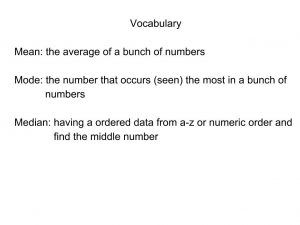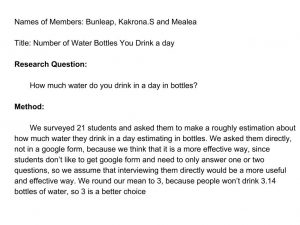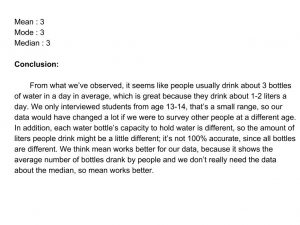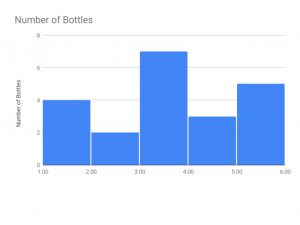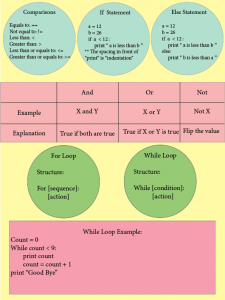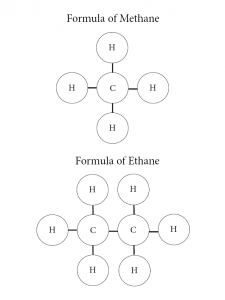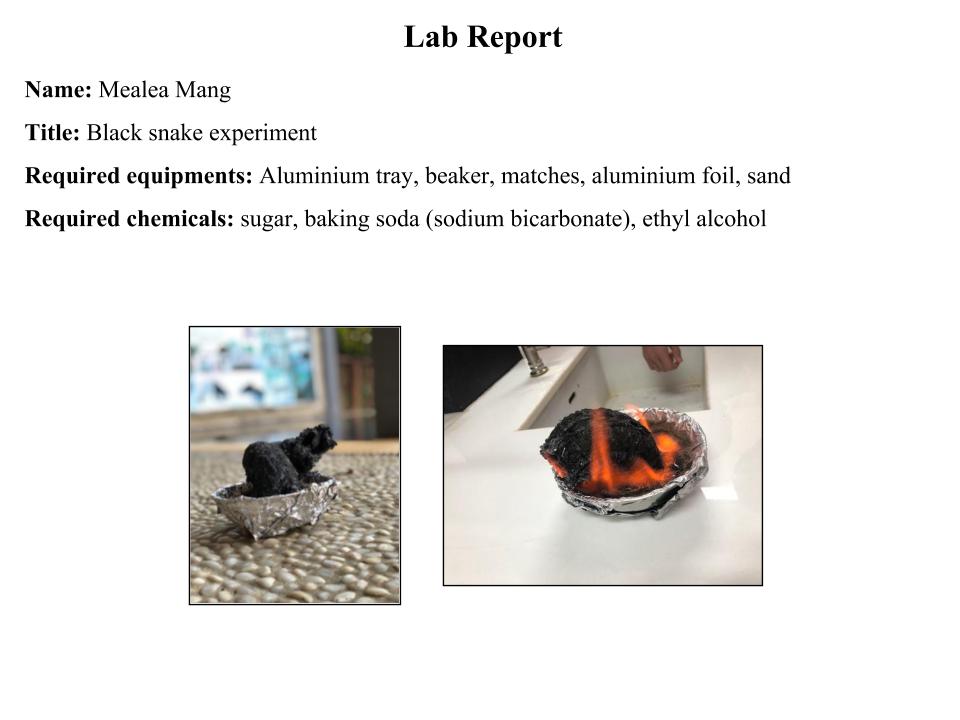It’s never been better to get to try something new, especially when it comes to academic learning and this round is it. In these 7 weeks, we were taught about volume of cubic objects, percentages, angles and data analysis. I found Data Analysis most interested, because this is one of the school lessons that could be applied to real life, so by paying a lot of attention to this topic is worth it and it makes the most of the my learning as well. We actually did a project with three members in a team and we chose a question to ask to collect data and complete the project as seen below.
Learning Programming Language
We are currently learning about programming language, Python in particular. We clearly didn’t learn everything about python in just 4 weeks. We only focus on conditionals and if statements. We studied a few data type in python such as; booleans, strings, integers, etc… and different comparisons. Every language clearly has its own grammar, how you would speak or write correctly, so does programming language. Python has its own “grammar”, meaning that if you want it to do something, you need to write it in a way that it could understand in a particular format that’s created for just this particular programming language. “Indentation” is one of the most common error. It’s basically the spacing in front of a statement or condition. It’s really important, because that’s how the computer knows which code belongs to which statements, etc…
We then learned about “if” and “else” statements, it’s mainly about checking if a condition is true or false and giving a result as an output. To add on, we also learned about “And”, “Or” and “Not”. It’s like a word that connects two different statements together to check. We use “and” if we want to check if both conditions between it are both true. We use “or” when we want to check if one of the condition is true and we use “not” to flip the value around.
We should sometimes work smart than work hard, like how the “for” loop works. You could give it a fixed number for it to run just as how many times as you want. You could also use “break” to stop the entire loop or “continue” to skip to the next repetition. For even easier, you could use the “while” loop, where it continues forever until the condition is false, which means as long as the condition is true, it’ll continue to run, but you need to make sure that it won’t go forever, there should be something that would stop the loop.
វេយ្យាករណ៍-គុណនាម
គុណនាមមានន័យថា ពាក្យ សំដីសម្រាប់សំដែងសភាពលក្ខណៈរបស់នាម ។
ប្រភេទនៃគុណនាម
- គុណនាមប្រក្រតី
- គុណនាមចំនួន
- គុណនាមកម្មសិទ្ធ
- គុណនាមចង្អុល
- គុណនាមសំណួរ
- គុណនាមមិនច្បាស់
- គុណនាមប្រក្រតី គឺសម្រាប់ប្រាប់លក្ខណៈរបស់នាម។
ឧទាហរណ៍ៈ គោខ្មៅធាត់ជាងគោស។
គុណនាមប្រក្រតីមានៈ ល្អ កខ្វក់ ស វែង ខ្លី សម្បូរ ខ្សត់…។
- គុណនាមចំនួនជាគុណនាមសម្រាប់រាប់។ គុណនាមចំនួនមានពីរយ៉ាង:
១. ចំនួនរាប់សម្រាប់រាប់ឲ្យដឹងចំនួន
ឧទាហរណ៍ៈ ឪពុកខ្ញុំមានគោប្រាំនឹម។
ចំនួនរាប់មានៈ ពីរដំបរ ប្រាំរយ ប្រាំខាំ ប្រាំឡូ…។
២. ចំនួនរៀបសម្រាប់រាប់ឲ្យដឹង ទី ជាន់ ថ្នាក់
ឧទាហរណ៍៖ ដាណេ រៀនថ្នាក់ទីប្រាំបី
ចំនួនរៀបមានៈ ទីដប់ ម៉ោងប្រាំ ជាន់ទីមួយ…។
- គុណនាមកម្មសិទ្ធសម្រាប់ប្រាប់ម្ចាស់កម្មសិទិ្ធ ។
ឧទាហរណ៍ ៖ រាជរដ្ឋាភិបាលជាអ្នកសាងសង់ផ្ទះពួកគាត់ ។
គុណនាមកម្មសិទ្ធមានៈ ខ្ញុំ ឯង វា គាត់ នាង យើង ពួកគាត់ គេទាំងអស់គ្នា…. ។
- គុណនាមចង្អុល ប្រាប់ទីកន្លែងនិងពេលវេលាណាមួយ ។
ឧទាហរណ៍៖ សាលារៀននេះជាសាលារៀនខ្ងុំ ឯខាងនោះជាសាលាឃុំ ។
គុណនាមចង្អុលមាន ៖ នេះ នោះ ទីនេះ ទីនោះ…. ។
- គុណនាមសំណួរ គឺប្រើប្រាស់សម្រាប់ចោទសួរ។
ឧទាហរណ៍ ៖ តើមិត្តទិញសៀវភៅអ្វីខ្លះ?
គុណនាមសំណួរមាន ៖ អ្វីខ្លះ ប៉ុន្មាន អ្វី ស្អី ណាខ្លះ ណាមួយ…. ។
- គុណនាមមិនច្បាស់ គឺជាគុណនាមប្រាប់សេចក្ដីមិនជាក់លាក់ មិនប្រាកដ ។
ឧទាហរណ៍ៈ ខ្ងុំ មិនដឹងថា គាត់ចង់បានចេកមួយណាទេ ។
គុណនាមមិនច្បាស់មាន៖ អ្វី ណា អ្វីខ្លះ មួយណា ណាខ្លះ ឯទៀត ដទៃ
អ្វីមួយ….។
A New Theme-Identity
A new theme is always chosen for a new round of the school year. This round’s theme is “Identity”. Before going deep into Identity, I was questioned by some simple questions, but not simple answers. “Who are you?”, “What defines you?”, “What makes you who you are?”. It couldn’t get any harder when it comes to understanding yourself. I was borned in a family, where I’m the youngest and we adore dogs. To my family, dogs aren’t just pets, but family; they are part of us. I’m from a place called “home”, a warm, cozy place, where smiles and joy are shared. I’m from a place, where I first see sunlight, a place where I’m taught to be a grateful child, a loyal friend, a great student and a respectful leader. It’s the genes I got from my parents and the environment around me that made me who I am today. They are the ones who shaped my personalities, my behaviors and my actions. We then wrote a vignette about the meaning of our names.
My Name by Mealea Mang
My surname, Mang Rathanak Mealea, is quite a long name to have, but I love having a long name. My first name was given by my grandfather and my middle name was given by my aunt. I don’t really use my middle name, “Rathanak” a lot, just because it is really long, so I usually just use my first and last name.
My name has a really beautiful meaning, Rathanak, my middle name means diamond or gold or something valuable and Mealea means floral or flower. Interesting fact about my first name is that, it could be found on the Khmer dictionary! Most of the Cambodians have their last name named after their grandfather’s first name, like me. Actually, my last name is written in a French way, “M-A-N-G”, if I could I would change the spelling to “M-O-N-G”; it is still not the right pronunciation, but at least close, closer than “M-A-N-G”.
People sometimes would pronounced my name “Melea”, instead of “Mealea” and no one has pronounced my last name correctly on first try yet. I am not upset when people called me “Melea”, but I am not really happy when people pronounced my last name incorrectly, but I am used to it now. People also say that my name sounds really aggressive. I am kind of aggressive just like how my name sounds like, because my mom has the personality of kind and aggressive at the same time. That’s how I get this trait of mine.
Fun facts: my name is actually the title of one of the most famous Khmer novels called “Mealea Duong Chet”; it means “florals in someone’s heart”. My name sounds really familiar to most of the Cambodians, since the novel is really well-known all over Cambodia. Surprisingly, my name is the name of one of the temple in Siem Reap. It is a really old temple built in the early 12th century.
Despite from opinions from others, I feel like this name doesn’t represent me that well, but I love it and I really don’t want to change my first name, because it is something that my grandfather left for me before he passed away and I would never change my name to anything.
Afterwards, we learned about literary devices, elements that a great author uses to create fascinating effects to the story. I found it really helpful, because these elements are just things that we need in a story to make it amazing and with literary devices, it just makes the atmosphere when you are reading more realistic and able to visualize. These literary devices create imaginary images in our mind and extend our creativity.
We are currently in groups of 3-5 people reading the same book with the theme of “Identity”. There are four different books to choose from; Outsiders, Wonder, Looking for Alaska and Monsters. I chose to read Monsters, because it’s totally a different taste of reading for me. Every week, we have a book discussion, where everyone in the team is assigned for a role, such as; the summarizer, the word detector, inferencer, symbolizer and visualizer. We switch roles every week and we basically just discussed about the book as one of the five roles listed before.
An author always has his/her purposes of writing the books. They might want the book to be educational, entertaining, informative, persuasive or descriptive. They might choose to add some opinions or facts or add different literary devices to give some amazing effects to the book.
This round’s theme has caught my eyes so much and I am really looking forward for next round’s theme. I could guarantee that it’s going to be another exciting theme.
“Element of Life”
It’s never been better to study something new, especially when it comes to chemistry. Carbon is basically the main focus of this round, but what is carbon? What makes Carbon so special that we focus on only carbon the whole seven weeks? Well, we didn’t actually spend the whole 7 weeks, because we only study stem every other week, which means we only studied about three weeks or so. Back to the topic, Carbon is everywhere, because 0.04% of the atmosphere is made out of Carbon. Carbon is known as the “element of life”, because all living things contain carbon in them. Besides just carbon, we studied hydrocarbons and carbon dioxide. Hydrocarbon is a compound combination of hydrogen and carbon only. Carbon needs to bond with four other elements around it to be a complete hydrocarbon. There are different prefix for different hydrocarbon, such as:
Meth: 4 hydrogens and 1 carbon
Eth: 6 hydrogens and 2 carbon
Prop: 8 hydrogens and 3 carbon
But: 10 hydrogens and 4 carbon
Pent: 12 hydrogens and 5 carbon
Hex: 14 hydrogens and 6 carbon
Hept: 16 hydrogens and 7 carbon
Oct: 18 hydrogens and 8 carbon
Non: 20 hydrogens and 9 carbon
Dec: 22 hydrogens and 10 carbon
Below shows some examples of hydrocarbon.
Afterward we did a black snake experiment and wrote a lab report about the experiment.
Decimals
In the middle of round 3, we got our new book, the 5B. We then started learning the first lesson of the book; decimals. Fraction and decimals obviously are related, because they are both used to count partial numbers, just that we sometimes prefer one over another, which is totally fine. We first learned the basic terminology and just required things that we need to know about decimals before learning how to do operations between decimals and decimals or decimals and whole numbers. Afterwards, we studied on how to convert between fractions and decimals back and forth. Of course, we then do practices; mostly we have assignments with due dates on Khan Academy, a self-learning online tools that students and educators could use to help their learning. We already finished learning decimals and we’ll continue the next lesson next round.
Khmer Literacy-Round 2
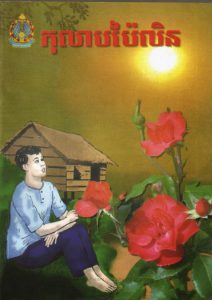
A novel that is known all over Cambodia is now being introduced. Kolab Pailin or The Rose of Pailin is a novel written by a really famous author, Nhok Thaem. He has written many other books as well and this is one of the best novel he wrote. This novel is a very educational and could really relate to real life. Other than learning about Kolab Pailin, we also learned the history of Water Festival and Kathina. These are two famous ceremonies that are celebrated in Cambodia. The Water Festival is celebrated to remind us at time when our king defeated the enemy by water way, so we celebrated the ceremonies every year during November by having a boat race. Kathina is a celebration that is only celebrated in the Buddhism religion. We celebrated in the Vossa season, the rainy season. We usually go to pagodas and offer the monks different things, like sugar, tea, candles, clothes for the monks, etc… I find these lesson really helpful, because as a Cambodian citizen, we should know all about the history and what we do on the ceremonies.
Another Lesson to be Introduced
As the new round starts, new lessons are being introduced. We mostly focused on area and perimeter of different polygons, like triangles and rectangles. Aside from learning new things, we were also given a lesson on code.org that is related to algebra. I found the lesson really helpful, as we are now introducing to algebra little by little. The code.org lesson is just something we could do outside of class, just for extra practice for algebra. On the last unit of the book, we learned about ratios and did some fun projects relating to budgeting, recipes and number of students and staffs in school. To make sure we understand the content, we did a lot of exercises that includes word problems; word problems are sometimes very tricky, but I really think word problems are the best, because they help me both with the math and the words usage with math. I found this round really interesting and excited and I’m even more excited for the new book, 5B.
Chemical Bonding
As mentioned before, we are still focusing on physical science, but this time we look a little deeper into the periodic table and chemical bonding. We basically learned about who created and rearranged the periodic table, how the periodic table is formatted and we also learned about the elements in the periodic table. We didn’t focus on every single one of the element, but we focus on the important and common ones. Furthermore, we look closer into chemical bonding, which includes covalent bonding, ionic bonding and metallic bonding, which are related to electrons in the element. We study closely on each bonding and give examples on all of them to make sure that we are fully understood. Ck12 is a website, where we learn all of our contents from.
English Literacy-Round 2
The second round of the year starts off with the study of social and environmental injustice; social injustice is basically about how people are treated unfairly, due to their race, origins, religions, etc… Environmental injustice is quite related to social injustice, as it is about how the environment affect human life. As we are learning, we completed a hyperdoc about minority groups in Connecticut and how the power plants affect them, since most of the power plants in the state are located near the minority groups territory. Besides that we are currently focusing on writing argumentative essays. As a warm up, we did something called Philosophical chair, where a topic or statement is given and students need to choose to agree or disagree and they will debate and give turns respectfully. Before writing the argumentative essay, we also learn tips and skills to write an argumentative essay. That includes devil advocate, writing thesis statement, choosing evidence, integrating source and more.

